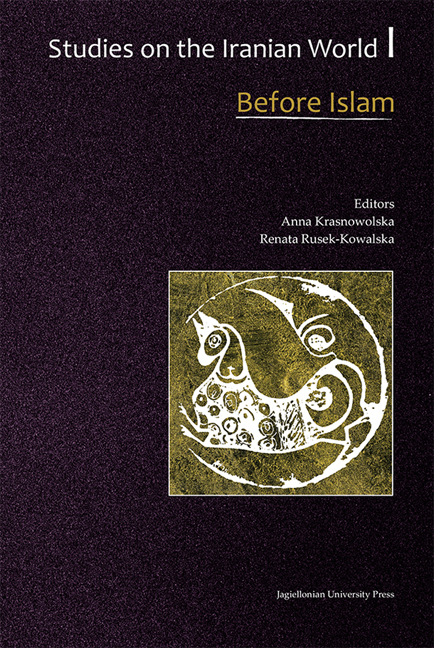Book contents
- Frontmatter
- Contents
- Foreword
- Linguistics
- The Old Persian Genitive. A Study of a Syncretic Case
- Nominal Compound Strategies in Middle Iranian Languages
- Alan Place-names in Western Europe
- Work in Progress: The Catalogue of the Buddhist Sogdian Fragments of the Berlin Turfan Collection
- Preliminary Remarks on Middle Persian ‹nc› in the Pahlavi Documents
- Literature
- Religion
- History
- Archaeology
The Old Persian Genitive. A Study of a Syncretic Case
from Linguistics
Published online by Cambridge University Press: 12 January 2018
- Frontmatter
- Contents
- Foreword
- Linguistics
- The Old Persian Genitive. A Study of a Syncretic Case
- Nominal Compound Strategies in Middle Iranian Languages
- Alan Place-names in Western Europe
- Work in Progress: The Catalogue of the Buddhist Sogdian Fragments of the Berlin Turfan Collection
- Preliminary Remarks on Middle Persian ‹nc› in the Pahlavi Documents
- Literature
- Religion
- History
- Archaeology
Summary
SUMMARY
Old Persian does not have separate forms for genitive and dative, as formerly distinct grammatical categories merged into the genitive. Indeed, a detailed examination of Old Persian textual data reveals that the genitive expresses a variety of syntactic functions and semantic roles, cross-linguistically typical not only of the genitive, but also of the dative. This scenario can be accounted for by considering the Old Persian genitive case as a polysemic radial category, the expression of the Possessor being the core function and other attested functions being metaphorical extensions. The aim of this paper is to analyse Old Persian dative-genitive syncretism. The evidence from a crosslinguistic perspective suggests that the semantic or functional overlapping of genitive and dative cases has been the main cause of this syncretism, given the tendency of languages to eliminate synonymous grammatical forms over time.
INTRODUCTION
As is well-known, case syncretism is a phenomenon that has taken place in many Indo-European languages, and involves a reduction of the number of cases when compared to the system usually reconstructed for Proto-Indo- European. This paper will focus on the syncretism of the Indo-European dative and genitive in Old Persian (henceforth OP) – where the syncretic process had already occurred and the dative case had totally disappeared – and argue that this change affected cases with partially overlapping semantic content and similar syntactic functions. The merging of the functional load of the two original cases into one ending resulted in the polysemy of the surviving morpheme, namely the genitive. Given these premises, an examination of OP raises at least two important questions: (1) the nature of the syncretism that is to be reconstructed; (2) the processes that brought about the loss of the dative case.
A few preliminary remarks are in order to frame the subsequent analysis. First of all, the important theoretical notion of syncretism should be considered. Following Meiser (1992: 190) and Luraghi (2000), this term is used to indicate a diachronic process comprising the integration of two or more originally distinct paradigmatic categories into a single category, either through the merging of their form or of their underlying functions.
Secondly, we will adopt a cognitive-functional approach as a methodological framework.
- Type
- Chapter
- Information
- Studies on the Iranian World: Before IslamMedieval and Modern, pp. 13 - 30Publisher: Jagiellonian University PressPrint publication year: 2015



